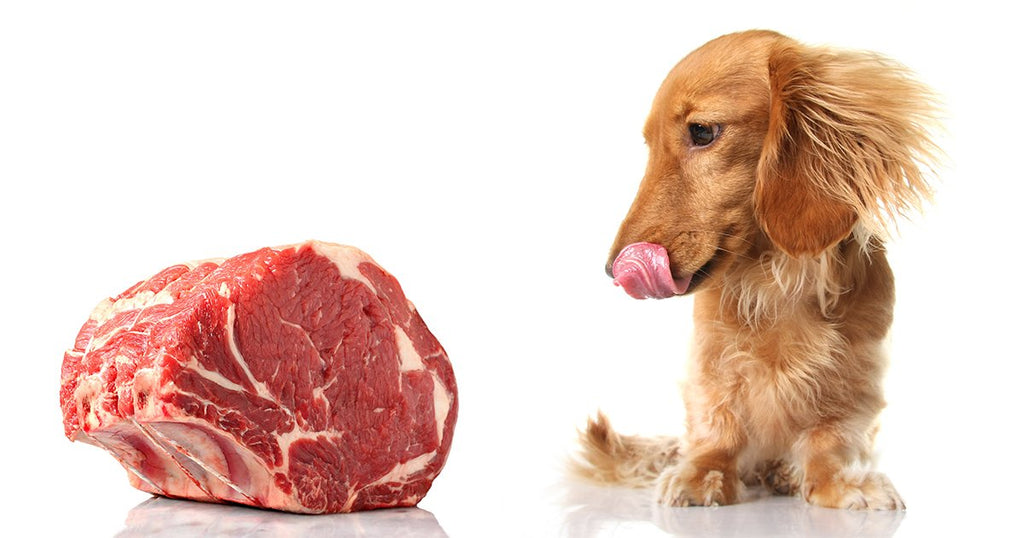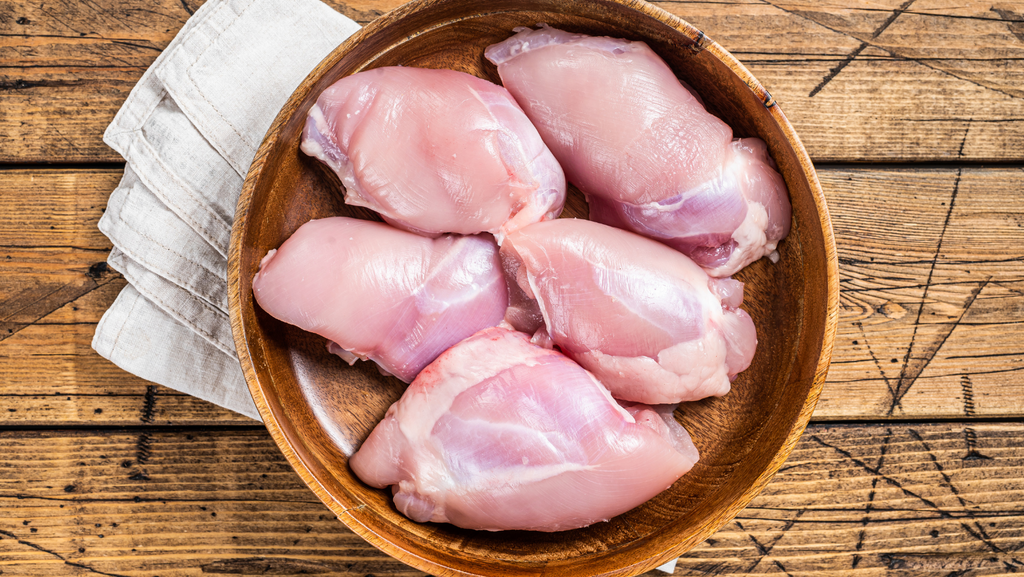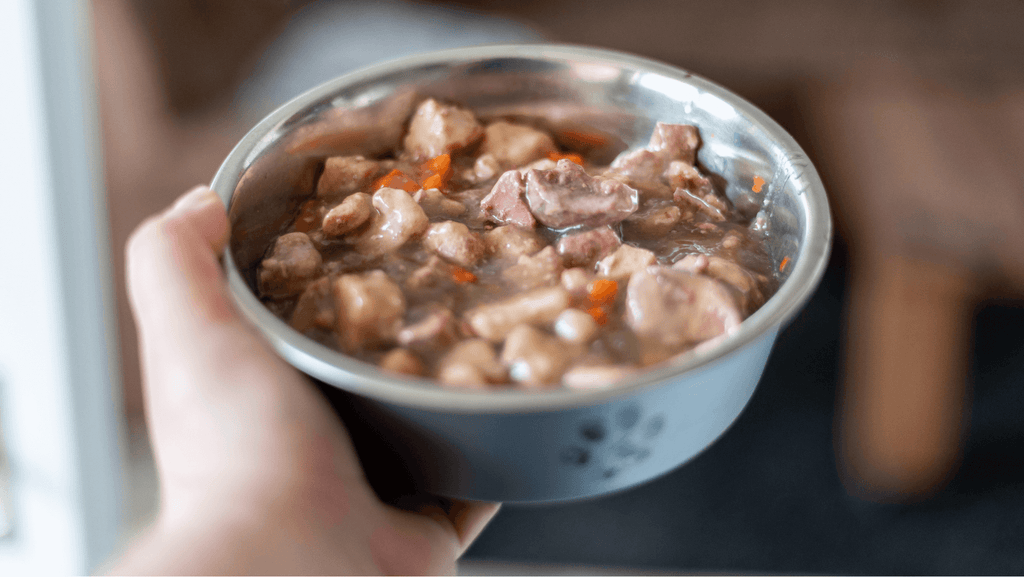3 Simple Raw Dog Food Recipes For Weight Loss

A raw food recipe can help your dog lose weight while providing plenty of other benefits. Many dogs on raw diets see a boost in energy, mood, and over physical health. Of course, if making your dog raw meal was as simple as heating up a tv dinner, you wouldn’t be here, would you?
Don’t worry. We’re here to help. With an estimated nearly 40% of Australia’s dogs being obese or overweight, we want to help Aussie pups regain their health with our insight into healthy raw recipes you can make at home.
Once you’ve gotten the hang of making your dog’s raw homemade food, the task of meal prep becomes much easier. And most importantly, you will begin to see a difference in your dog’s physique and a renewed sense of excitement for life.
Is Raw Food Good For Weight Loss
There are many reasons dog owners switch their doggos to a raw diet, and, yes, weight loss is one of them. But what makes a raw diet a better choice for helping your dog slim down? Let’s take a closer look at how raw diets help dogs (and people) drop pounds and feel great.
What Makes a Raw Dog Diet Better for Weight Loss?

With a homemade raw dog food diet, what you see is what you get. You know exactly what your dog is eating, and you can calculate your dog’s caloric intake more easily. That’s not the only reason raw diets help dogs lose weight, though.
Raw diets have fewer calories than cooked meals of the same volume [1]. This is because cooking requires extra oils and fats both in the cooking process as well as preserving the food to be shelf-stable [2].
When you feed your dog raw dog food, they feel fuller because they can eat a large amount and still remain within their caloric range.
A raw dog diet is also rich in fibre, real protein, and whole plants, so your dog’s body can process their food more effectively, giving them more energy to partake in fun (calorie-burning activities).
What Are the Other Benefits of a Raw Dog Food Diet?
The biggest benefits of feeding your dog raw foods include:
- Vibrant energy
- Better sleep
- A shiny coat
- Healthy skin
- Better dental health and fresher breath
- A more muscular build
What You Need to Know About Homemade Dog Food

Our philosophy is simple: every dog deserves healthy dog food. When it comes to healthy raw dog food recipes designed for weight loss, you have to get the balance of ingredients right in order to ensure your dog’s nutritional needs are met. You also want to ensure that you’re handling and storing your dog’s food safely. Luckily, we know a thing or two about making the best raw dog food.
When making homemade dog food, be sure to follow these guidelines:
Protein and amino acids: Dogs must have protein in their diets. These proteins can be a blend of vegetable protein and real meat protein. This is because dogs require 10 amino acids their bodies cannot produce on their own, and your dog’s body uses the protein’s carbon chains to convert glucose into energy [3].
Your dog’s diet should be 30%-52% calories from protein.
Fats and fatty acids: Fats in a dog’s diet come from animal fats, such as fish oil, and seed oils, such as flaxseed oil. While “fats” may sound like a bad thing, they’re anything but bad in moderation. In fact, your dog’s body cannot pull vitamins from their diet without fats [4]. And fat gives your dog energy to burn.
Your dog’s caloric intake should be 47%-63% fat.
Carbohydrates: Carbs include vegetables, fruit, and nuts. These provide your dog a boost of vitamins, minerals, and fibre.
Vitamins & minerals: Of course vitamins and minerals are important for your dog’s body. They help form strong bones, dense muscles, and aid in blood clotting and brain function.
To tailor your dog’s raw food recipe to their individual needs, you will want to consult your vet. They can give you guidance as to how much caloric restriction your dog needs.
Most dogs should consume the equivalent to about 2% of their body weight daily. You can use our dog food calorie calculator as a great starting point to make the math easier.
3 Simple Raw Dog Food Recipes
Raw Dog Food Recipe 1: A Doggie Meat-and-Three
This recipe offers excellent real meat protein, tasty vegetables, and flavorful fish oil. You can switch out the meat type from time to time since dogs benefit from variety.
Here is the base of the recipe. You can multiply the ingredients to make more to freeze.
Ingredients:
- 300 g ground raw meat, including some organs and bone (up to 33% bone and organ)
- 100 g vegetables and fruits, blended
- 10 g fish oil
- Vitamins and minerals from a supplement
For this recipe, you will want to mix your ground meat with blended vegetables and other ingredients. Separate enough to feed your dog for four days and freeze the rest.
Raw Dog Food Recipe 2: Doggo Burgers
If you want a beefy treat for your dog, these Raw Doggo Burgers are a wonderful option. This recipe is simple to make, but you will need a large mixer and a blender.
Ingredients:
- 2,200 g lean ground beef
- 500 g beef heart
- 500 g beef liver
- 1,000 g vegetables, blended
- 125 g ground flaxseed
- 50 g seaweed
- 10 g fish oil
- Vitamin and mineral supplement
Mix all ingredients thoroughly. Form into patties. Separate enough to feed your dog for four days and freeze the rest.
Raw Dog Food Recipe 3: Rabbit, Chicken, & Beef Trio
This recipe is great for dogs on a diet because rabbit will be a fresh new flavour and with lean beef, your dog will receive quality proteins without excessive calories.
Ingredients:
- 1,100 g Rabbit, ground with organs and some bone
- 500 g Chicken hearts, ground
- 500 g vegetables, blended
- 125 g Beef liver, ground
- 4 eggs
- Vitamin and mineral supplement
Mix together your ground rabbit, chicken hearts, and beef liver. Add your vegetable puree into the mix. Add all remaining ingredients. Separate about 4 days worth of meals and freeze the rest.
The Best Ingredients for Raw Feeding
Once you feel comfortable making your dog’s food, you can begin to play with new recipes or modify these three. The Meat-and-Three makes for an extremely versatile recipe to substitute different meats, veggies, and fruits based on what’s on sale or what’s in season. If you want to give your dog great variety, here are some excellent options for raw dog food ingredients.
Substitute your dog’s meat protein with

- Beef
- Chicken
- Duck
- Kangaroo
- Lamb
- Rabbit
- Venison
Rotating or substituting your dog’s meat protein source can help prevent food sensitivities, improve nutrient diversity, and keep mealtime exciting. Each protein has unique benefits—from iron-rich beef to lean kangaroo and novel proteins like venison and rabbit.
Looking for a nutrient-dense beef option to add variety to your dog’s diet? Try Got Beef with Superfood Extras—a premium blend enriched with natural superfoods to support energy, digestion, and overall wellness.
The best vegetables for a raw dog diet:

- Carrots
- Celery
- Cauliflower
- Okra
- Green beans
- Peas
- Pumpkin
- Spinach
- Squash
- Sweet Potato
Including a variety of vegetables in your dog’s raw diet helps support digestion, provide essential vitamins, and contribute to overall wellness. For an added boost to skin, coat, and heart health, consider incorporating healthy oils into their meals. Discover The Health Benefits of Sunflower Oil and how it can complement your dog’s raw food regimen.
Excellent fruit choices for your dog’s raw recipes:

- Apples
- Bananas
- Blueberries
- Cantaloupe
- Honeydew melon
- Strawberries
- Watermelon
Yummy “Cheat Day” Treats for Your Dog on a Diet
If you have a picky eater, or your dog is grumpy about being on a diet, you can supplement a small portion of their meal for one of these tasty add-ons.
- Almonds
- Cottage cheese
- Plain yogurt
- Raw eggs
- Sunflower seeds
Handling Your Dog’s Raw Food
Raw foods are highly beneficial, but when you’re handling raw meat, you always have to take precautions to not cross-contaminate your kitchen or other foods.
Wash any surfaces that come in contact with raw meat well. Thoroughly wash your dog’s bowl after each meal. Rinse or wash the outside of any food containers that came in contact with raw dog food before putting them in the fridge or freezer.
Raw Feeding Is a Great Way to Help Your Dog Lose Weight

You only want to serve your dog the best ingredients made with love, and a homemade raw food diet is a great way to do that. When you take the time to make homemade raw dog food, you are able to control exactly what goes into your dog’s food to ensure it’s the best. Just remember to consult your vet to ensure your dog’s caloric intake is correct and to adjust any recipes to better fit your dog’s unique dietary needs.
When you feed raw, you will see your dog slim down over time and regain the energy they once had.
Don’t have time to make your own homemade dog food? Petzyo’s raw dog food uses only the freshest ingredients, and we deliver!
One popular option for weight-conscious pups is Roo’s Clues with Superfood Extras.
A lean, nutrient-rich recipe packed with natural superfoods to support healthy weight loss and vitality.
References:
[1] Raw Foods Diet
[2] A Science-Based Guide For Pet Owners
[3] Fats for Dogs




